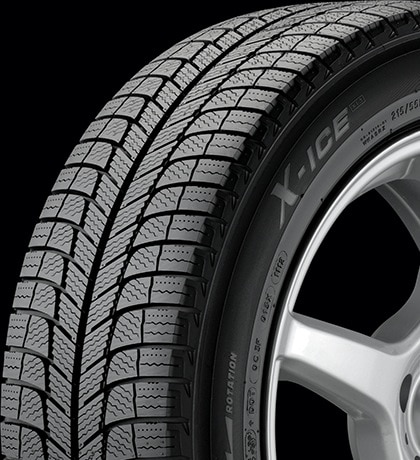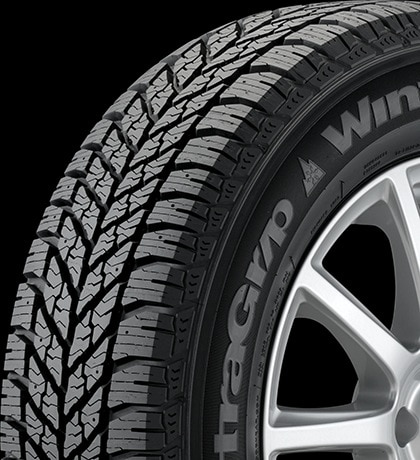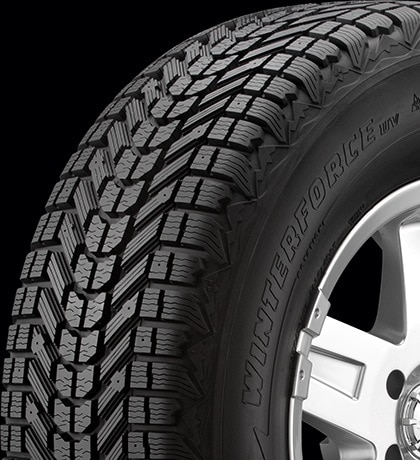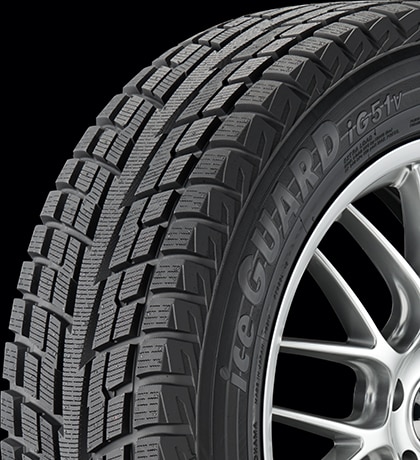Winter is coming and, once again, you have to buy winter tires for your car and, once again dealers, independent auto shops, and tire shops will try to convince you that they have the best tires you can find on the surface of the earth.
With all those different tire models, options, and features made by numerous different manufacturers, how are you supposed to know which one is truly the best fit for you? To answer that, we have created a list of some of the best winter tires based on your specific needs and budget. We’re also providing a quick guide to help you find a set you will like without having to break the bank for unnecessary bells and whistles.
6 Best Winter Tires for Cars, Trucks, and SUVs
The Bridgestone Blizzak has been one of the best-known tires in the automotive industry for a long time now. With the WS80, the latest addition to the Blizzak range, Bridgestone unveils the sixth generation of this tire, first launched in the 90s.
Like its predecessors, the Blizzak WS80 uses a rubber designed to adhere well to ice and snow, even in freezing temperatures. Its behavior on the ice is exemplary while the design of the sole and the block design make it extremely effective in deep snow.
The WS80 used to have a bad reputation for premature wear but this is now something of the past. Bridgestone engineers have completely redesigned the Blizzak to achieve better performances without sacrificing fuel efficiency and durability.
These tires feature the next generation of Multi-Cell Gum Compound to prevent skidding on icy surfaces. This special rubber compound helps to keep the treads as flexible as possible to achieve outstanding performances on icy and snow-covered roads.
It is, without a doubt, one of the best winter tires to help you beat snow and ice. Its got a reliable cold-weather grip and long durability and comes with one of the most reasonable price tags on the market.
Michelin X-Ice Xi3

What makes the quality of a tire is first and foremost the rubber compound. Some manufacturers have developed a rubber compound that provides good durability while making no compromises in terms of grip and Michelin is one of them. The main advantage of the Michelin Xi3’s compound is that it helps maintain the sportiness of the vehicle regardless of the temperature.
These winter tires have very firm sidewalls. This reduces the bending of the tires while cornering. Michelin has been able to maintain flexibility and thus, the performance of the tires. It offers a better feeling of the road to the driver while also enhancing the drivability on snow and ice.
Moreover, Michelin uses a good amount of silica in its rubber compound to increase the overall grip of the tire. It also reduces wear in warmer weather conditions. Micropump technology is used to draw water from under the tire to evacuate it more efficiently. That helps to reduce aquaplaning and enhance grip at the same time.
Continental Winter Contact SI

The Continental Winter Contact Si (for Snow and Ice) has been developed to outperform and replace the Extreme Winter Contact, particularly in terms of braking power on ice, resistance rolling, and fuel economy. The Extreme Winter Contact was really popular a few years ago. And the Winter Contact SI clearly retains its main virtues of cornering and braking.
It is a lot quieter than the previous version though. The unidirectional outsole with its closer V-shaped blocks is quiet and filters the imperfections of the road. The tread has slicker blocks made of a strong rubber compound for a better grip. However, at 10/32″ it’s shallower than the former ExtremeWinterContact.
This Continental model comes equipped with traction grooves that provide more bite and the Polar Plus + technology, a silica compound that help the tires to remain flexible in very cold weather. This allows the Continental Winter Contact SI to provide excellent traction on snow. It’s got better traction than most on slippery roads and a significantly reduced braking distance even in the worst winter weather.
Worth mentioning, the Continental Winter Contact SI also features an alignment verification system called the Alignment Check System. It allows visual detection of the parallelism of the vehicle’s wheels. It also lets you correct the problem before the tires are ruined beyond repair.
Goodyear Ultra Grip Winter

The Goodyear UltraGip Winter tires are an excellent choice as an entry-level product for drivers of passenger cars, sedans, SUVs, and crossover vehicles. If you have a more limited budget but still desire solid performances in winter weather, this is a solid choice.
The treads of the Ultra Grip Winter feature an innovative compound that ensures stable, safe driving. It has wide circumferential grooves favoring the evacuation of snow, slush, and water. It also offers a directional structure and many biting ridges. This studdable winter tire offers better handling and increased traction on roads covered in snow, slush, or ice. You will have maximum grip on wet or dry pavement.
The Goodyear Ultra Grip Winter has solid, shoulder-reinforced solid blocks that result in more even tread wear for a longer life-span. It’s also designed to receive studs to optimize traction on ice and ensure even better performances are achieved in the worst winter conditions. Definitely, a tire to look for if you have to drive a lot on countryside roads, deep snow, and frozen roads.
Firestone Winterforce UV

The Winterforce is a general-purpose, mid-entry level, radial tire available at an affordable price. The spaced blocks of the sole make this tire especially efficient in deep snow. Sadly, because of the inherent design of those same spaced tread blocks, it’s not a tire intended for driving on ice.
It’s worth mentioning that it’s probably the noisiest tire on this list. It’s definitely more oriented to fit off-road enthusiasts and those who like to wander off the grid where the ability to perform in deep powder overcomes the inconvenience of the higher noise level.
In addition, the slats are not full depth, so the grip on ice can decrease rather quickly. To compensate for the lack of performance on the ice, these tires are studdable for added traction on icy roads and this is where the tread design can come in handy. Shallower treads allow for a thicker sole which is perfect to achieve extended durability with studded tires.
I think it’s pretty fair to say that the Winterforce is a valid compromise between high-end performance tires and cheap Chinese tires like Sailun, Triangle, Snow Lions, and the likes. Let just say it’s an economical tire of acceptable quality without more. It’s perfect for those on a budget and customers looking for cheap and effective winter tires to install on their second car without cutting on safety and drivability.
Yokohama iceGUARD iG51v

These are pretty much the same as the Super Z6 but as the name suggests (the LT part), they’re designed for Light Trucks and SUVs. They’re basically the SZ143 Super Z6 with larger and tougher components. They’re all designed to handle the extra weight or demand of a bigger vehicle.
The Security Chain Co. say that these are the “fastest, easiest install of any traction product”, but the reality is, most of the chains in this list are easy to install, once you know how they install, so it really is down to what is your preferred brand or style – a tire cord/traction device or tire chains.
If you are looking for the best truck tire chains, then the ZT735 Super Z LT is the better choice than the SZ143.
Construction
Whether it’s a snow chain, traction cord, traction device, they all use high-quality steels, but just in a different manner.
With traction devices or cords, you normally get a steel cord, wrapped in some kind of protective coating, which is then typically wrapped in a coiled steel ‘spring’ – this allows for less wear both on the tire and the road surface.
Traction cords and devices are usually much easier to install, often needing no extra vehicle movement (for instance, driving on to the chains), and have no need for extra tensioning once they’ve been driven on – they have automatic adjusters and tensioners.
Fit and Finish
The other downside to snow chains, as opposed to traction cords, is that they typically need much more space around the wheel of the vehicle, and this is a big factor when considering a purchase – will your vehicle actually allow chains or cords to be fitted?
Some traction devices need minimal clearance – as little as a quarter of an inch around the tire, and for most ‘regular’ cars, these are the sort of traction devices you’ll need, but if you’re running an off-roader, or even perhaps an SUV, you may be able to fit something bigger.
You should also be aware that these devices are quite technical, and don’t allow for much tolerance in the fitting, so you can’t just order a set for a 16-inch tire, for example, you need to know the exact dimensions of the tire – width, height, aspect ratio, etc. Many of the manufacturers have exact listings, but if you’re not sure, get in touch with them to find out.
Lastly, we’d say that it’s worth doing a dry run with them – you don’t want to find yourself stuck by the side of the road trying to fit snow chains or traction cords if A) you have no idea how they fit your tire and B) they don’t actually fit!
BONUS:
Conclusion
Remember that any tire traction aid or snow chain will only allow you to travel at a maximum of 30 mph, and while it’s tempting to push that if the conditions clear up, just don’t – a damaged snow chain or tire traction cord could result in severe damage to your vehicle.
If you’re fitting snow chains, you need a set on each driven wheel or axle, so if you have four-wheel drive, you’ll need two sets – fitting just one set could result in damage to the gearbox or differential, or trigger a fault with the traction control system – the electronic control systems on newer vehicles can be great, but once they flag a problem, it could just leave you stranded anyway, regardless of traction devices.
In some states, carrying a set of snow chains is a legal requirement when the weather turns bad. And for the price of some of these snow chains, it’s worth investing in some just to leave in the trunk, even if you never use them.
Finally, light oiling on the chains will help prevent any maintenance issues if you’re storing them for the summer months – especially the tire cords.



